I’m super excited to share with you the secrets of cooking vegetables in a slow cooker. It’s a total game-changer! With a slow cooker, you can create delicious and healthy meals with minimal effort. That’s what I love about slow cooker veggie cooking. You can easily find the best vegetables for slow cooker and get started right away.
Imagine coming home to a warm, comforting meal that’s been cooking all day in your slow cooker. It’s the perfect way to unwind after a long day! Whether you’re a beginner or an experienced cook, you’ll find that slow cooker veggie cooking is a great way to add some variety to your meals. It makes cooking vegetables in a slow cooker a breeze.
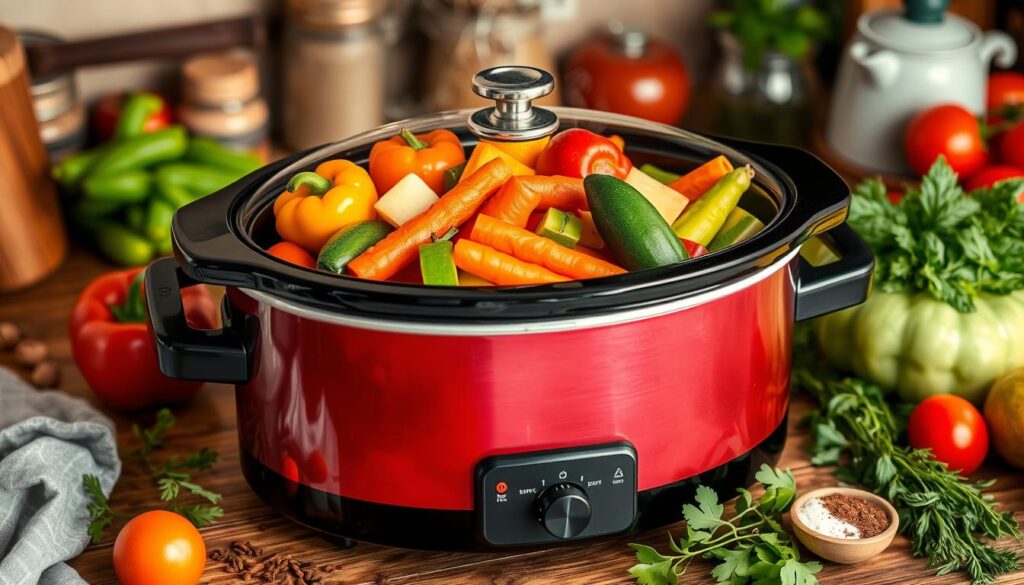
I’m here to guide you through the process of slow cooker veggie cooking. From choosing the best vegetables for slow cooker to mastering the art of cooking vegetables in a slow cooker. So, let’s get started and discover the magic of slow cooker veggie cooking together!
Key Takeaways
- Slow cooker veggie cooking is easy and convenient
- Cooking vegetables in a slow cooker can be healthy and delicious
- You can find the best vegetables for slow cooker and get started right away
- Slow cooker veggie cooking is perfect for home cooks of all skill levels
- Cooking vegetables in a slow cooker can add variety to your meals
- Slow cooker veggie cooking is a great way to make meal prep easy
Table of Contents
The Magic of Slow Cooker Veggie Cooking: Benefits and Basics
Exploring slow cooker veggie cooking is exciting. I’m eager to share its benefits and basics with you. A common question is how long to cook veggies in crock pot. The answer changes based on the vegetable type. But, a slow cooker ensures perfect cooking every time.
Slow cooker veggie side dishes add flavor and nutrition to meals. Knowing how long to cook vegetables in crock pot helps make tasty dishes. You can cook many vegetables, like greens and roots, easily and with great taste.
Why Choose Slow Cooking for Vegetables
Slow cooking is great for veggies because it keeps nutrients and flavors. It’s perfect for making simple sides or complex stews. Slow cooking offers several benefits:
- Easy to use and clean
- Energy-efficient
- Perfect for busy home cooks
Essential Equipment for Success
To start slow cooker veggie cooking, you need a few things. You’ll need a slow cooker, a cutting board, and basic kitchen tools. These help you make tasty dishes like roasted veggies, stews, and soups.
Preparing Your Vegetables for the Slow Cooker
Now that we’ve covered the basics of slow cooker veggie cooking, it’s time to talk about preparing your vegetables for the slow cooker. This step is key to the flavor and texture of your dish. It’s important to choose the best veg for slow cooker recipes.
Preparing your veggies is a chance to get creative. You can chop, slice, or dice them to fit your recipe. Some veggies, like carrots and potatoes, are great for slicing. Others, like broccoli and cauliflower, are better chopped. The goal is to mix textures and flavors well in crockpot veggie side dishes.
Here are some tips for preparing your veggies:
- Chop or slice your veggies to the right size for your recipe
- Marinate or season your veggies before adding them to the slow cooker
- Experiment with different combinations of veggies to find your favorite
By following these tips and using the best veg for slow cooker recipes, you’ll be well on your way to creating delicious and flavorful crockpot veggie side dishes. Remember to have fun and experiment with different recipes and ingredients. Don’t be afraid to try new things!
Best Vegetables for Slow Cooking and Their Cook Times
Exploring slow cooking, I’m excited to share the best vegetables for it. From root vegetables to green beans, the choices are vast! The secret to crock pot vegetable side dishes is knowing how long to cook them to enhance their sweetness.
Vegetable side dishes cooked in a slow cooker can transform any meal. Let’s look at some favorites. Root vegetables like sweet potatoes and carrots need 6-8 hours on low. Cruciferous veggies like Brussels sprouts and broccoli cook in 4-6 hours. And for green beans and zucchini, 2-4 hours is enough.
Here’s a quick rundown of some popular slow-cooked vegetables and their cook times:
- Root vegetables: 6-8 hours (sweet potatoes, carrots, beets)
- Cruciferous vegetables: 4-6 hours (Brussels sprouts, broccoli, cauliflower)
- Tender vegetables: 2-4 hours (green beans, zucchini, bell peppers)
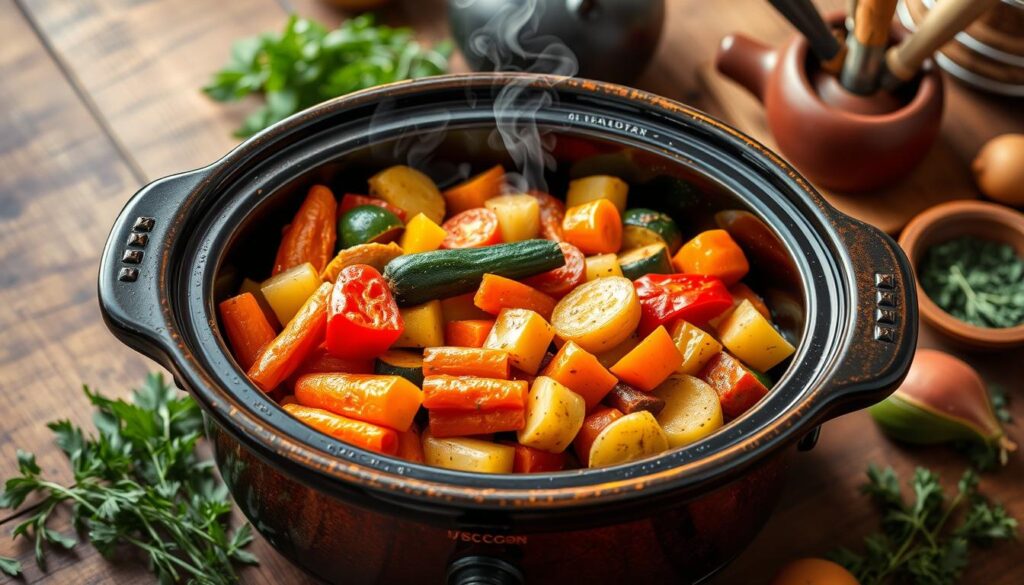
Keep in mind, these times are just a guide. You can adjust them to your liking for texture and tenderness. With practice, you’ll make delicious crock pot vegetable side dishes that will be a kitchen staple!
Mastering Liquid Ratios and Seasonings
Exploring slow cooking reveals the importance of mastering liquid ratios and seasonings. I enjoy trying out different broths, stocks, and water to achieve the perfect balance. This is essential for making tasty vegetable recipes. Whether it’s a side dish or a main course, the right liquid ratio is critical.
When slow cooking, consider the vegetables you’re using and how they’ll mix with the liquid. For instance, roasted vegetables like Brussels sprouts and carrots add a deep flavor. On the other hand, tender veggies like green beans and zucchini might need a lighter liquid. By balancing your liquid and seasonings, you can make a memorable vegetable recipe.
Here are some tips to get you started:
- Use a mix of broths, stocks, and water for a rich flavor.
- Try different seasoning combinations, like herbs, spices, and marinades, to find the perfect blend.
- Add a splash of acidity, like lemon juice or vinegar, to enhance your flavors.
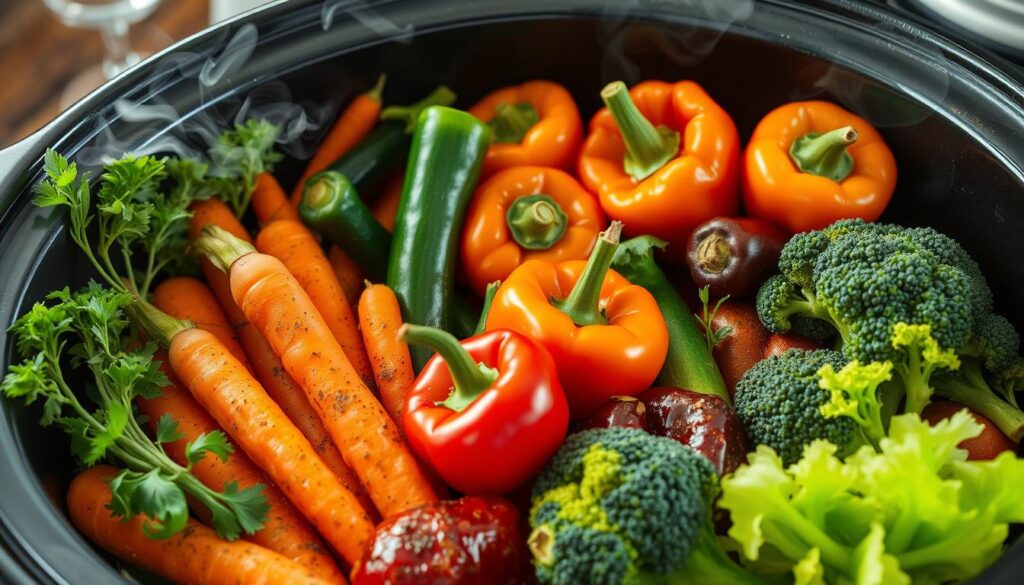
Remember, mastering liquid ratios and seasonings is all about tasting and adjusting as you go. Don’t hesitate to experiment and try new things. Most importantly, have fun with it! With practice and patience, you’ll be whipping up delicious, slow-cooked side dishes and vegetable recipes in no time.
Creating Flavorful Vegetable Side Dishes
Exploring slow cooker recipes, I love sharing my top tips for tasty vegetable side dishes. Whether you’re new to cooking or experienced, these ideas will spark your creativity. You’ll enjoy making and eating healthy, delicious meals.
It’s key to know the cooking times for different veggies. For instance, green beans cook faster than others. Here’s a quick guide:
- Green beans: 2-3 hours on low
- Carrots: 3-4 hours on low
- Broccoli: 2-3 hours on low
To make your side dishes more flavorful, use herbs, spices, and seasonings. Try different liquids like broth or coconut milk. This will help you create unique, tasty slow cooker recipes.
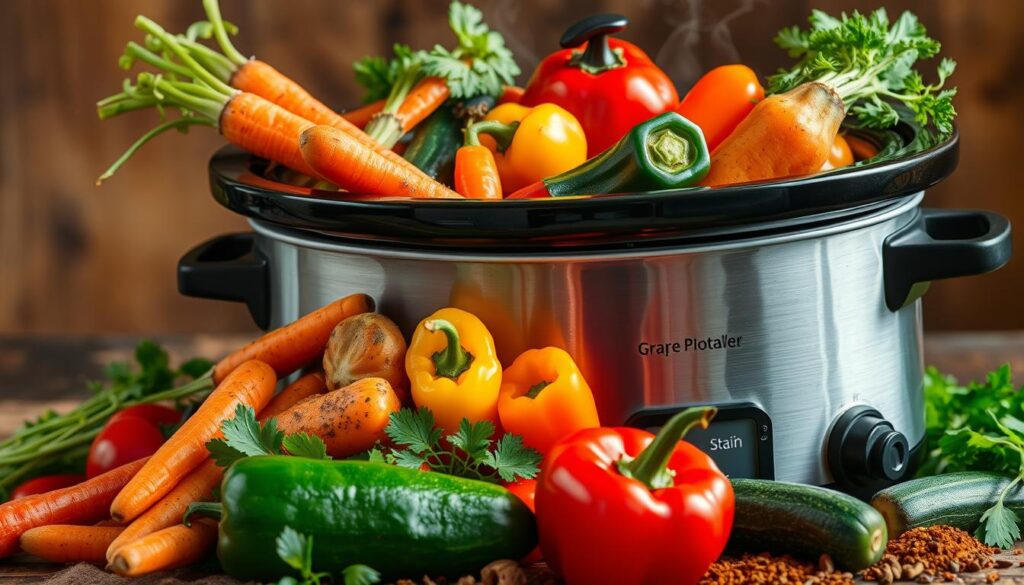
Popular side dishes include Mediterranean veggies, Asian veggie medleys, and classic American comfort sides. Don’t be afraid to mix things up and create your own unique dishes. The options are endless!
| Vegetable | Cooking Time | Seasoning Suggestions |
|---|---|---|
| Green beans | 2-3 hours | Garlic, lemon juice, salt, and pepper |
| Carrots | 3-4 hours | Cumin, coriander, and honey |
| Broccoli | 2-3 hours | Soy sauce, ginger, and sesame oil |
Troubleshooting Common Slow Cooker Vegetable Problems
When you try new recipes with sweet potatoes and brussels sprouts, you might face some issues. These problems can happen when cooking veggies in your slow cooker.
To solve these problems, I’ve got some helpful tips. Here are a few things to remember when cooking veggies:
- Prevent mushy vegetables by adjusting the cooking time and heat setting.
- Fix seasoning issues by tasting and adjusting the seasoning throughout the cooking process.
- Adjust cooking times based on the type and quantity of vegetables you’re using.
By following these tips, you’ll get delicious and tender veggies. Remember to always check the recipe and adjust the cooking time and seasoning as needed. This will ensure the best flavor and texture.
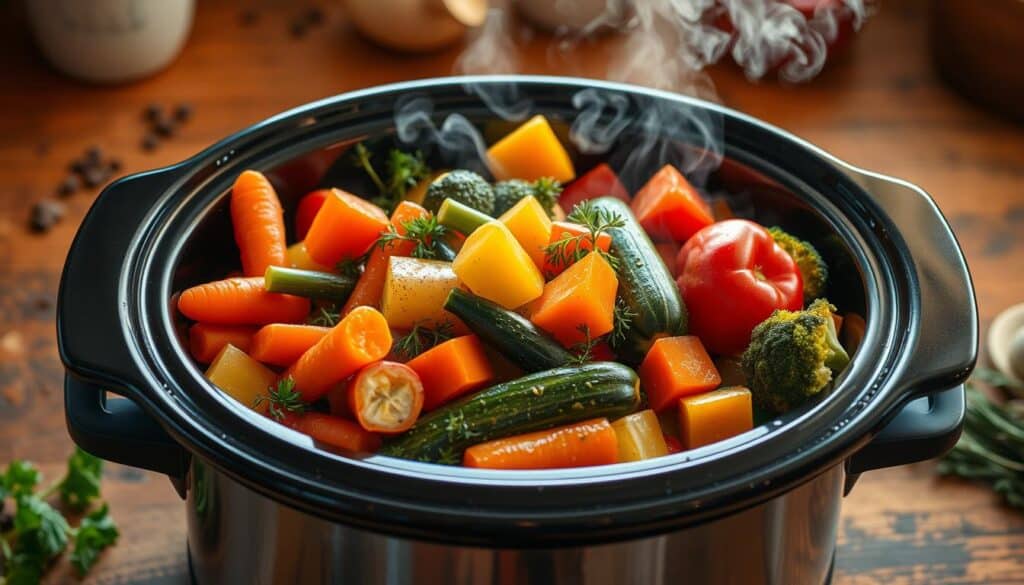
With a little practice and patience, you’ll become a pro at cooking veggies in your slow cooker. You’ll enjoy a variety of healthy and flavorful meals!
| Vegetable | Cooking Time | Heat Setting |
|---|---|---|
| Sweet Potatoes | 4-6 hours | Low |
| Brussels Sprouts | 2-3 hours | High |
Conclusion: Making Slow Cooker Vegetables Part of Your Weekly Menu
Exploring slow cooker veggie cooking reveals a world of flavor and ease. It’s perfect for busy cooks or seasoned chefs. Adding slow cooker veggies to your menu can change the game.
With affiliate links to olive oils and crock pots, you can build a collection of favorite recipes. These recipes turn simple ingredients into delicious meals. You can make everything from chicken and veggie medleys to vegetable broth soups.
Keep adding liquid as needed and season with salt and pepper. Let your slow cooker work its magic for 3-4 hours. Slow cooker veggies can become a key part of your meals. They offer nourishment, flavor, and convenience that everyone will love.
FAQ
What are the benefits of slow cooking vegetables?
Slow cooking veggies in a crockpot keeps nutrients in. It also makes flavors better and makes veggies tender. Plus, it’s easy to do with little effort.
What type of vegetables work best in a slow cooker?
Root veggies like sweet potatoes and carrots are great. So are hearty greens and cruciferous veggies like Brussels sprouts and broccoli.
How long should I cook vegetables in a slow cooker?
Cooking time varies by veggie and heat setting. Generally, 3-4 hours on low or 1-2 hours on high is a good rule.
Do I need to add liquid when cooking vegetables in a slow cooker?
Adding a bit of liquid like broth or water helps. It keeps veggies moist and cooks evenly.
How can I prevent my slow cooker vegetables from becoming mushy?
To avoid mushy veggies, cut them big and add them late. Don’t overcrowd the cooker.
What are some tasty seasoning combinations for slow cooker vegetables?
Try Italian herbs, garlic, onions, and balsamic vinegar. Soy sauce and spices like cumin or chili powder also work well.
Can I cook vegetables in a slow cooker without any liquid?
Yes, you can cook veggies without liquid. But adding a bit of broth or water helps prevent drying or burning.

2 thoughts on “Unlock Flavor & Convenience: Slow Cooker Veggie Cooking”